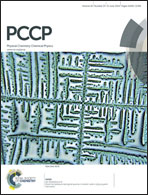Interaction in the indole⋯imidazole heterodimer: structure, Franck–Condon analysis and energy decomposition†
Abstract
The complex of indole and imidazole has been studied using a combination of theoretical chemistry techniques, with the relevant calculations compared to existing experimental resonant two-photon ionisation data. Results of fitted multidimensional Franck–Condon simulations based on ground and excited state geometry optimizations and harmonic vibrational frequencies confirm that the V-shaped herringbone structure is that observed by experiment. The ground state interaction energy of these important biomolecular building blocks has been evaluated at a benchmark quality level using explicitly correlated coupled cluster theory, and the V-shaped structure is shown to be approximately 2 kcal mol−1 more strongly bound than other possible conformers. The non-covalent interaction energy is decomposed into physical components using symmetry-adapted perturbation theory and it can be seen that although electrostatics dominate the interaction, dispersion plays a vital role in determining the optimal geometry.


 Please wait while we load your content...
Please wait while we load your content...